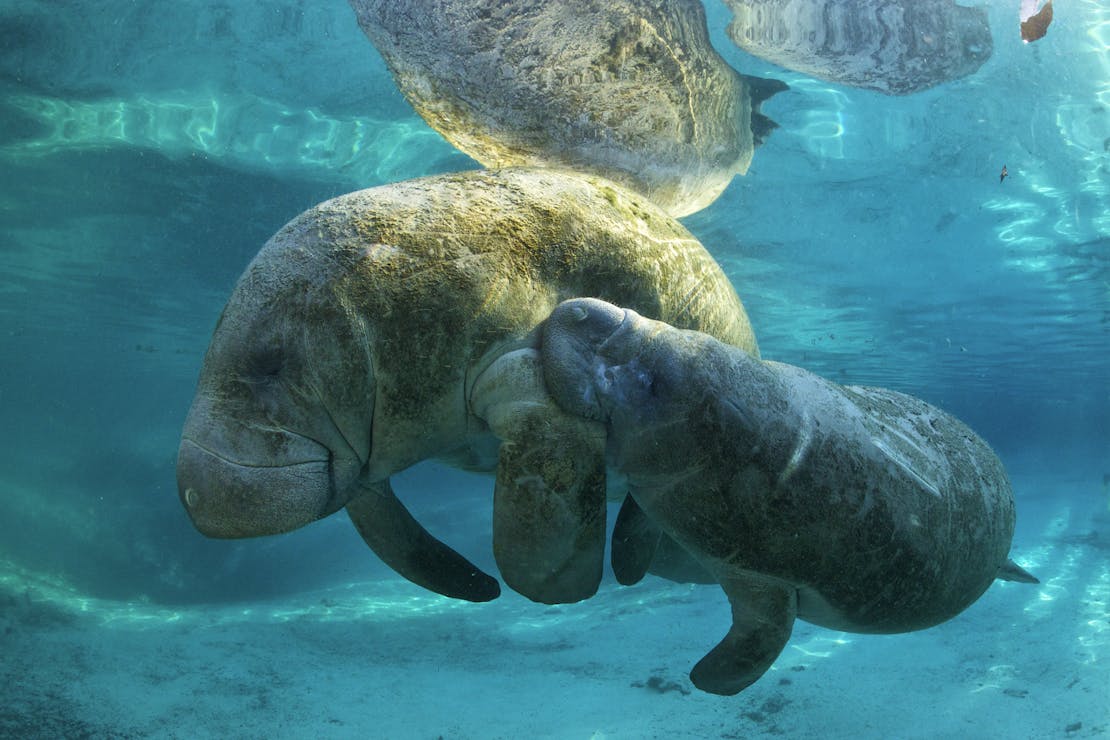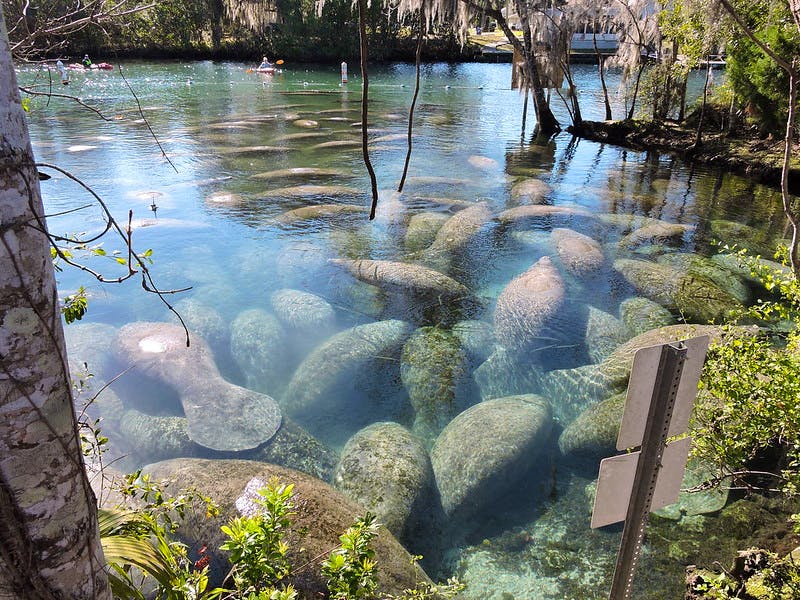About Florida manatees
Florida manatees are a subspecies of the West Indian manatee native to the southeastern United States. Primarily found in saltwater, brackish and freshwater habitats in Florida, these unique animals—colloquially known as “sea cows”—graze on grasses and other aquatic vegetation in shallow waters. Manatees are herbivores that eat large quantities of sea grasses and freshwater plants. Like other grazing animals, they play an important role in influencing the plant growth in the shallow coastal waters, estuaries, bays, canals and rivers where they occur. Manatees can help prevent vegetation from becoming overgrown and they consume water hyacinth and other invasive species, improving the health of the ecosystem. Manatees are also important sources of fertilization for sea grasses and other submerged aquatic vegetation.
Threats to Florida manatees
November is Manatee Awareness Month, a time when these sea cows, move to warmer waters in Florida. Aside from its ecological role, the manatee is an iconic flagship species that is beloved by many. At the same time, restrictions on boating and coastal development to protect manatees have proven to be a lightning rod for controversy that has generated some backlash. Propellers and boat hulls inflict serious or mortal wounds, and most manatees have a pattern of scars on their backs or tails after surviving collisions with boats.
Although no one knows precisely how many manatees existed at any time in history, hunting of manatees is believed to be the cause behind their initial decline. The West Indian manatee was one of the first species listed as endangered under the Endangered Species Act (ESA) in 1973, and after decades of conservation efforts, it was downlisted to threatened in 2017. While a recent mean population estimate of the Florida manatee is 8,800 animals, the manatee is far from being out of the woods.
While watercraft collisions are the most significant immediate cause of manatee mortality, the greatest long-term threat to the manatee is lack of warm-water habitat that manatees need to survive. Coastal residential and commercial development continues to degrade manatee habitat. Manatees become susceptible to cold stress, which is often lethal, at temperatures below ~68F. Residential development has greatly reduced the natural springs used by manatees to thermo-regulate, and more than 60% of the population aggregates in the warm-water outfalls at electric power plants on cold winter days. A significant number of manatees could be lost in the next few decades if natural areas are not available to manatees as aging plants are shut down or experience equipment failures; aerial counts have documented more than 2,500 manatees gathering in a single survey day at each of several plant locations. Their survival will depend on protecting natural spring flow and maintaining the integrity of ecosystems and habitat sufficient to support a viable manatee population.
Last year was a tough year for Florida manatees. Some 824 perished—just six shy of 2013’s record-high death toll of 830—from boat collisions, cold snaps and exposure to red tide. Named for the color it tints the water, red tide is an algal bloom that emits neurotoxins that also kill dolphins, sea turtles and other wildlife, and it can also cause breathing problems in humans.
Coexisting with Florida manatees
For many years, Defenders has been a leader in advocating for policies that protect manatees and their habitat and advance coexistence with this gentle aquatic mammal. Litigation by Defenders and other organizations in the 1990s led to a landmark settlement, creating 17 refuges and sanctuary areas as well as enforceable manatee protection speed zones.
Florida manatee management & recovery plans
We work at the state and federal levels to ensure that management and recovery plans are implemented utilizing the best available science. Our work to prevent the ESA from being weakened or politicians undermining specific species protections has never been more important. We have built good working relationships with the U.S. Fish and Wildlife Service (FWS) and the Florida Fish and Wildlife Conservation Commission (FWC) and Defenders is recognized as a voice of reason amid what are often controversial, heated and polarized discussions about manatee regulations. Agencies value our input, we have a strong presence on the Hill, expert backstopping from our legal team and ESA analysts, and that we can generate lots of comments from our online activists when needed.
Public education to help Florida manatees
Using web and print materials, Defenders of Wildlife provides information to boaters and others about responsible observation and interaction with manatees. We let people know that they should slow down in manatee habitat and obey posted speed zones. Boaters should avoid shallow areas with sea grass where manatees feed. Keep an eye out for signs of a manatee such as a nose, back flipper or tail breaking the water’s surface or a flat swirl on the surface indicating that a manatee is swimming close to the surface. And people should not feed, water or touch manatees, which is harassment and caused manatees to become conditioned to human interaction that can result in their harm.
Protecting Florida manatee habitat
We promote responsible stewardship of public conservation lands providing manatee habitat such as Crystal River National Wildlife Refuge, Blue Springs State Park and Ellie Schiller Homosassa Springs Park. Additionally, Defenders advocates for the restoration of manatee habitat, such as the dammed Ocklawaha River, as restoring the river by breaching the dam would make its 20 freshwater springs available as warm water winter habitat for many hundreds of manatees. Defenders’ Ocklawaha restoration advocacy has included helping to build and strengthen a coalition of NGOs who support restoring the river, raising awareness of the issue in publications such as the Orlando Sentinel and Medium, giving educational presentations, submitting relevant public comments, and looking forward, once FWC and FWS release their long-anticipated Warm Water Action Plan for manatees, Defenders will actively engage with agencies and utility companies to ensure that the plan’s implementation provides the maximum benefit to manatees.
While there is much to be done to ensure the continued survival of the Florida manatee, we have been a leader in bring about this iconic and ecologically important species’ recovery from its initial decline. Defenders of Wildlife is dedicated to continuing this important work to ensure the long-term survival of the Florida manatee.
Your support ensures our expert team of scientists, lawyers, advocates and activists have the resources needed to demand action and protection for wildlife across the nation.
Donate Today!


















Follow Defenders of Wildlife
facebook bluesky twitter instagram youtube tiktok threads linkedin